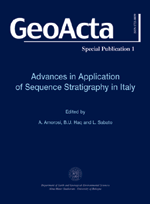GeoActa Special Publication 1
2008


Acquisto online |
GeoActa
an international Journal of Earth Sciences
|
|
Alessandro Amorosi1, Giovanni Sarti2, Veronica Rossi1, Vincenzo Fontana2
1Dipartimento di Scienze della Terra e Geologico-Ambientali, Università di Bologna, Via Zamboni 67, 40127 Bologna, Italy. E-mail: amorosi@geomin.unibo.it,
2Dipartimento di Scienze della Terra, Università di Pisa, Via Santa Maria 33, 56126, Pisa, Italy. E-mail: sarti@dst.unipi.it
|
|
|
Anatomy and sequence stratigraphy of the late Quaternary Arno valley fill (Tuscany, Italy)
|
|
|
|
|
|
|
|
PDF (780 KB)
|
Abstract
The late Quaternary Arno valley fill, in western Tuscany, was formed during the last glacio-eustatic cycle. It exhibits a total thickness of 35-40 m, and is 5-7 km wide. It consists almost entirely of a single transgressive succession emplaced during the post-Last Glacial Maximum transgression, between latest Pleistocene (13 cal. ka BP) and early Holocene (8 cal. ka BP). An indurated horizon, intensively reworked by pedogenic features, occurs lateral to the deep incision.
Above a fluvial deposit flooring the valley, the incised valley fill includes an early transgressive succession of coastal plain, bay head-delta, and estuarine deposits. As sea-level rise continued, the valley was filled and the interfluves flooded. Above the interfluve sequence boundary, the late transgressive Holocene succession is about 17 m thick, and includes a transgressive-regressive succession of coastal, shallow-marine and modern deltaic deposits.
Facies analysis of continuous cores and stratigraphic correlation of borehole data from the lower Arno coastal plain allow detailed reconstruction of three-dimensional facies architecture of the valley body. Alternating freshwater and brackish deposits form the valley fill at proximal-most locations. West of Pisa, the valley fill includes amalgamated estuary-mouth sand bodies, whereas at distal locations (beneath the present shoreline) it consists almost entirely of estuarine mud.
Subtle vertical facies changes within the valley fill allow identification and lateral tracing of three vertically stacked, shallowing-upward successions, about 10 m thick and bounded by flooding surfaces, which are interpreted as parasequences. Parasequence architecture suggests that sea-level rise close to the Pleistocene-Holocene boundary was punctuated by at least two distinct stillstand phases.
Keywords: Incised-valley fill, Sequence stratigraphy, Parasequence, Arno River, Quaternary.
|
|
|


